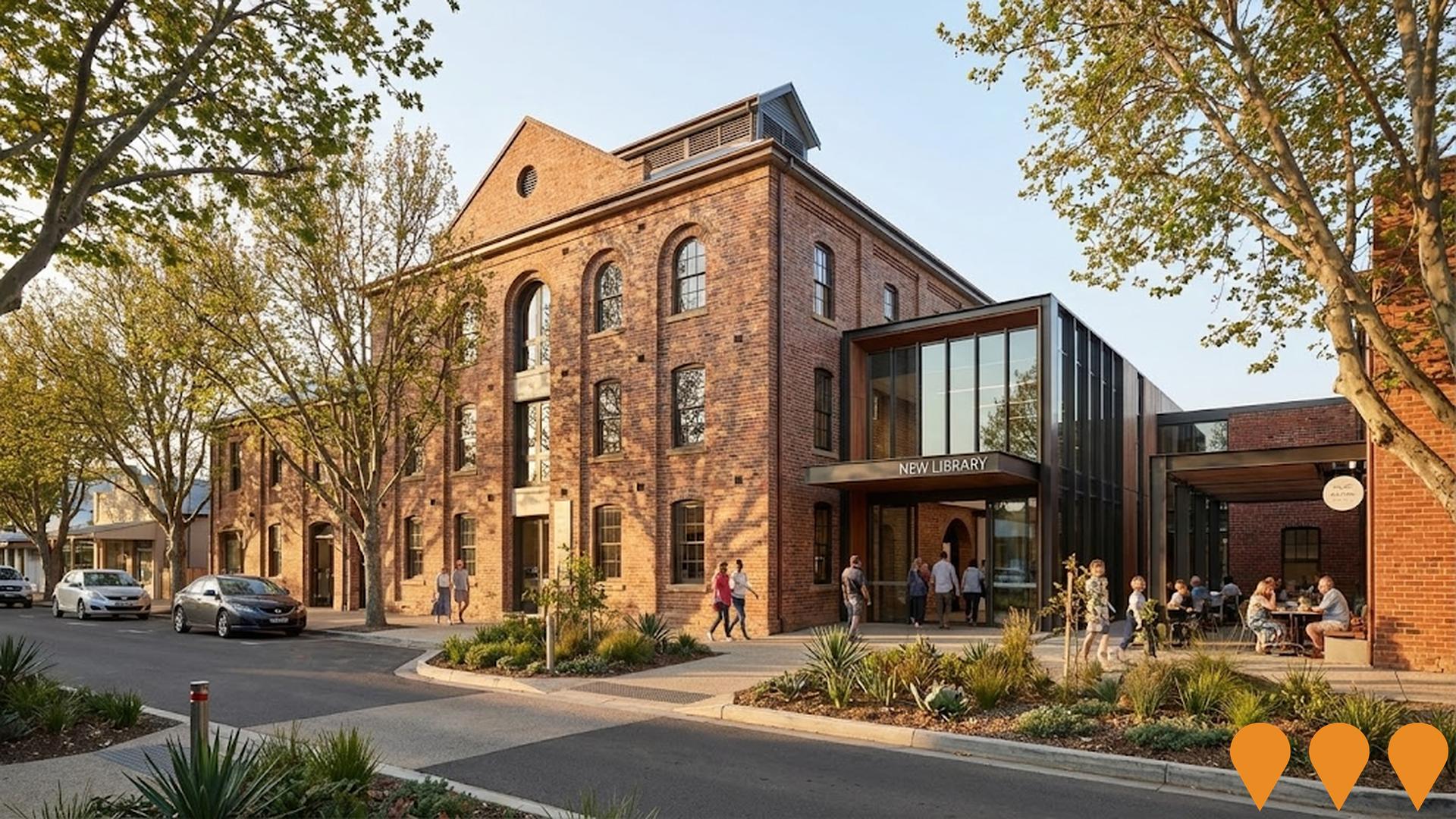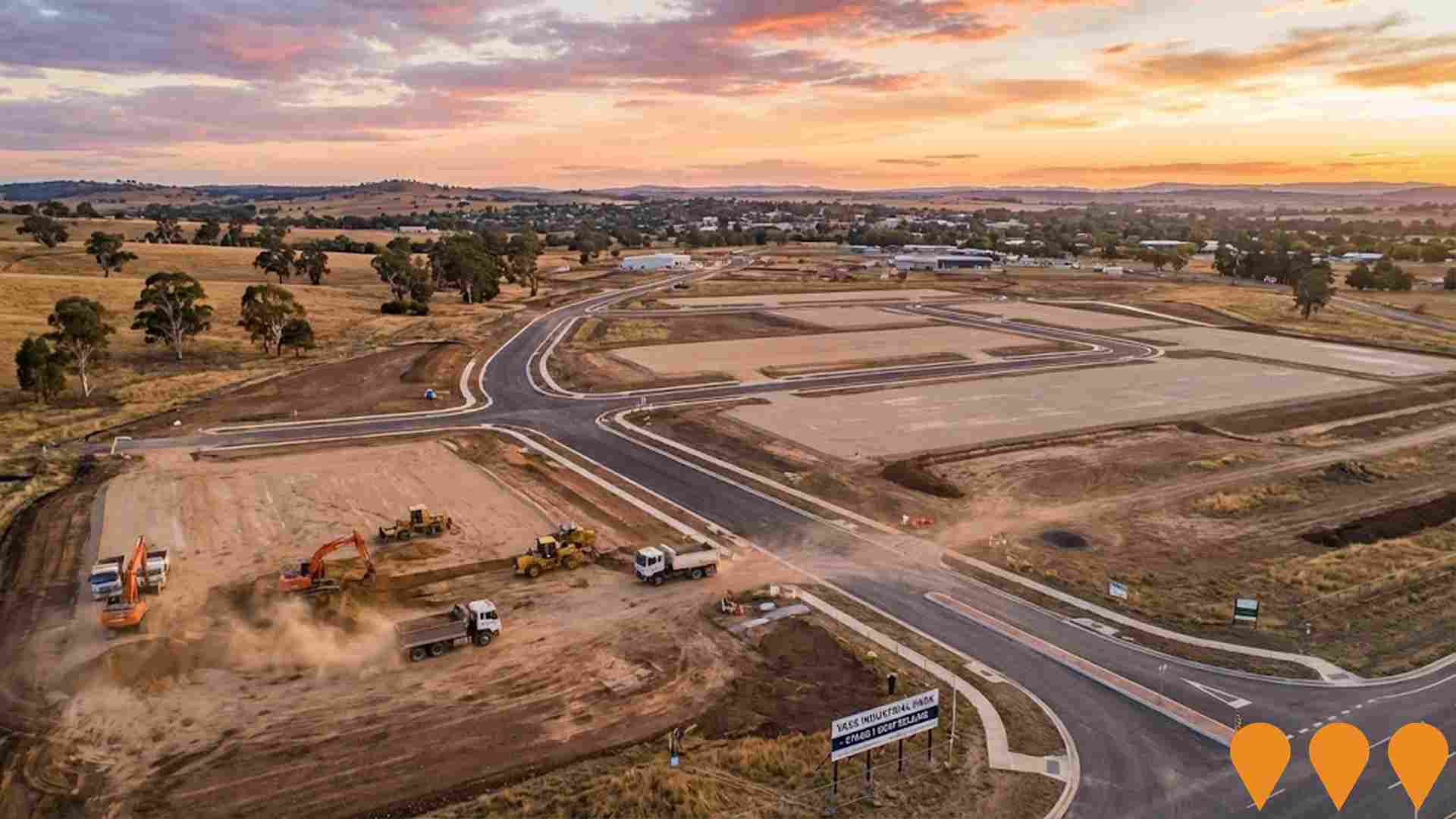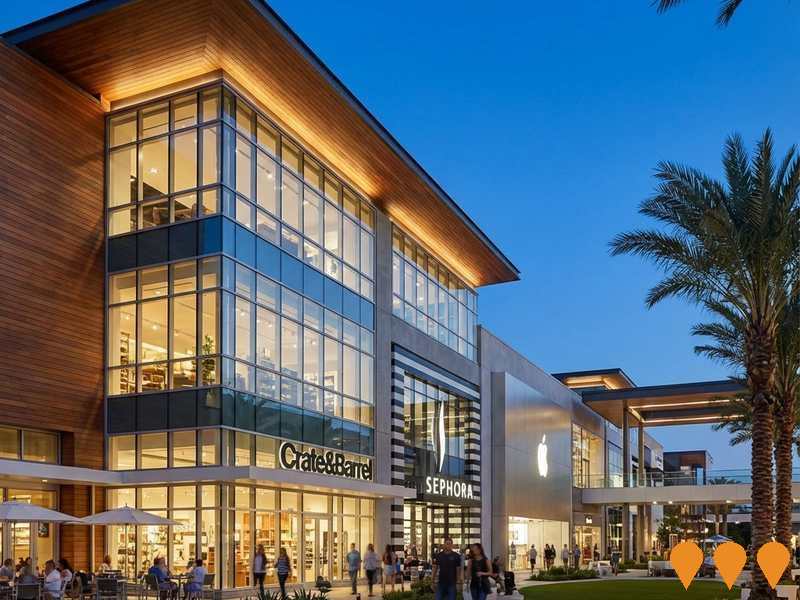Chart Color Schemes
est. as @ -- *
ABS ERP | -- people | --
2021 Census | -- people
Sales Activity
Curious about local property values? Filter the chart to assess the volume and appreciation (including resales) trends and regional comparisons, or scroll to the map below view this information at an individual property level.
Find a Recent Sale
Sales Detail
Population
An assessment of population growth drivers in Yass reveals an overall ranking slightly below national averages considering recent, and medium term trends
Yass's population is approximately 6,944 as of August 2025. This figure reflects an increase of 181 people since the 2021 Census, which reported a population of 6,763. The change is inferred from the estimated resident population of 6,817 in June 2024 and an additional 118 validated new addresses since the Census date. This results in a population density ratio of 69 persons per square kilometer. Yass's 2.7% growth since the census positions it close to the SA3 area's 3.2%, indicating competitive growth fundamentals. Overseas migration contributed approximately 70.9% of overall population gains during recent periods.
AreaSearch uses ABS/Geoscience Australia projections for each SA2 area, released in 2024 with a base year of 2022. For areas not covered by this data, AreaSearch utilizes NSW State Government's SA2 level projections, released in 2022 with a base year of 2021. Growth rates by age group from these aggregations are applied to all areas for years 2032 to 2041. Based on projected demographic shifts, the area is expected to expand by 256 persons to 2041, reflecting an increase of 1.8% in total over the 17 years.
Frequently Asked Questions - Population
Development
Residential development activity is lower than average in Yass according to AreaSearch's national comparison of local real estate markets
Yass has recorded approximately 29 residential properties granted approval annually over the past five financial years, totalling 147 homes. In FY-26 so far, 12 approvals have been recorded. On average, 0.3 new residents per year arrive for each new home constructed between FY-21 and FY-25. This rate suggests that new construction is meeting or exceeding demand, providing more options for buyers and potentially enabling population growth beyond current expectations.
The average expected construction cost of new dwellings is $517,000. In the current financial year, there have been $9.9 million in commercial approvals, indicating balanced commercial development activity. Compared to the rest of NSW, Yass has similar levels of development per person, supporting market stability aligned with regional patterns.
Recent construction comprises 85% detached houses and 15% medium and high-density housing, maintaining the area's traditional low density character focused on family homes. The location has approximately 208 people per dwelling approval, indicating a low density market. Population forecasts suggest Yass will gain 128 residents by 2041. With current construction levels, housing supply should adequately meet demand, creating favourable conditions for buyers while potentially enabling growth that exceeds current forecasts.
Frequently Asked Questions - Development
Infrastructure
Yass has moderate levels of nearby infrastructure activity, ranking in the 43rdth percentile nationally
Changes to local infrastructure significantly influence an area's performance. AreaSearch has identified 13 projects likely impacting the area. Notable ones include Crago Mill Precinct, Hamilton Rise Yass, Yarrah - Yass River Masterplanned Community, and Yarrah at Yass River. The following list details those most relevant.
Professional plan users can use the search below to filter and access additional projects.
INFRASTRUCTURE SEARCH
 Denotes AI-based impression for illustrative purposes only, not to be taken as definitive under any circumstances. Please follow links and conduct other investigations from the project's source for actual imagery. Developers and project owners wishing us to use original imagery please Contact Us and we will do so.
Denotes AI-based impression for illustrative purposes only, not to be taken as definitive under any circumstances. Please follow links and conduct other investigations from the project's source for actual imagery. Developers and project owners wishing us to use original imagery please Contact Us and we will do so.
Frequently Asked Questions - Infrastructure
Yass Hospital Redevelopment
Part of $300 million Multipurpose Service Program. Includes new emergency bed, palliative care suite, centralised nurses station, dedicated ambulance entry, on-site accommodation for visiting clinicians and security upgrades.

Crago Mill Precinct
The project involves the enhancement and conversion of the former Crago flour mill in the centre of Yass, including a world-class library with a children's area and study centre, cafe, community meeting rooms, small business centre/work hub, space for government tenants and community groups, public amenities, plaza, on-site carpark, and a new Council administration building and chamber.

Yass Industrial Park
30 hectares of industrial development for logistics, transport, freight, warehousing, building and construction, technology. B-Double and B-Triple accessible blocks with services including water, sewer, underground power.

Yass High School Upgrade
Upgrade to Yass High School delivering six new STEM teaching and learning spaces, three seminar rooms, new covered outdoor areas, new staff study facilities, and landscaping and accessibility improvements. Works are recorded by School Infrastructure NSW as a completed project, with a project gallery and information packs available on the official page.

Murrumbateman Public School
New public primary school serving Murrumbateman and nearby rural areas. Delivered by School Infrastructure NSW using modern construction methods with flexible learning spaces, COLA, library and hall. Opened Day 1, Term 1 2023 and designed for up to 370 students.

Yass Valley Plaza Retail Development
Modern shopping center on Comur Street featuring Woolworths supermarket, pharmacy, newsagent, fashion stores. Key retail hub serving Yass and surrounding communities.

Hamilton Rise Yass
Hamilton Rise is a master planned community in the Yass Valley, offering approximately 500 residential lots ranging from 620m2 to over 1000m2. It provides space and freedom with rural vistas and proximity to Yass CBD. Stage 1 construction is nearly complete, with blocks available for sale and house and land packages offered.

Yarrah - Yass River Masterplanned Community
Large staged residential subdivision on the Yass River delivering around 763 dwellings plus open space, a mixed-use activity centre, retirement living and a health services precinct. Stage 1 is complete with houses under construction; Stage 2A civil works commenced in 2024 with first homes underway in 2025; Stages 3 and 4 received DA approval in 2024 with further subdivision works planned through 2025.

Employment
Employment performance in Yass exceeds national averages across key labour market indicators
Yass has a skilled workforce with an unemployment rate of 2.4% as of June 2025. It has 3,465 residents in work, which is 1.2% below Rest of NSW's rate of 3.7%.
Workforce participation is 60.9%, compared to Rest of NSW's 56.4%. Key employment sectors include public administration & safety, health care & social assistance, and construction. Public administration & safety employs 2.3 times the regional level while manufacturing employs only 2.0% locally, below Rest of NSW's 5.8%. Over the year to June 2025, labour force levels decreased by 3.6%, employment declined by 4.3%, causing unemployment to rise by 0.7 percentage points.
National employment forecasts from Jobs and Skills Australia (May 2025) project a 6.6% increase over five years and 13.7% over ten years, with local growth estimated at approximately 6.5%% over five years and 13.2% over ten years based on industry-specific projections.
Frequently Asked Questions - Employment
Income
The area exhibits notably strong income performance, ranking higher than 70% of areas assessed nationally through AreaSearch analysis
Yass has a median taxpayer income of $61,885 and an average income of $76,422 based on postcode level ATO data aggregated by AreaSearch for the financial year 2022. This is notably higher than the national figures, with Rest of NSW having a median income of $49,459 and an average income of $62,998. By September 2025, estimates suggest the median income in Yass could reach approximately $69,689 and the average could be around $86,059, assuming a 12.61% growth rate from financial year 2022 as per the Wage Price Index. According to the 2021 Census, incomes in Yass cluster around the 55th percentile nationally. The income distribution shows that 33.1% of residents earn between $1,500 and $2,999 weekly. This is similar to the surrounding region where 29.9% fall within this income range. After housing costs, 85.6% of income remains for other expenses. The area's SEIFA income ranking places it in the 5th decile.
Frequently Asked Questions - Income
Housing
Yass is characterized by a predominantly suburban housing profile, with a higher proportion of rental properties than the broader region
In Yass, as recorded in the latest Census, 89.0% of dwellings were houses, with the remaining 10.9% being semi-detached, apartments, or other types. This compares to Non-Metro NSW's figures of 93.2% houses and 6.8% other dwellings. Home ownership in Yass stood at 34.7%, with mortgaged dwellings at 40.9% and rented ones at 24.4%. The median monthly mortgage repayment was $1,773, higher than Non-Metro NSW's average of $1,699. The median weekly rent in Yass was $340, compared to Non-Metro NSW's $270. Nationally, Yass's mortgage repayments were lower than the Australian average of $1,863, and rents were less than the national figure of $375.
Frequently Asked Questions - Housing
Household Composition
Yass has a typical household mix, with a fairly typical median household size
Family households account for 70.9% of all households, including 31.0% couples with children, 27.6% couples without children, and 11.4% single parent families. Non-family households make up the remaining 29.1%, with lone person households at 27.5% and group households comprising 1.6%. The median household size is 2.5 people, which matches the average for the Rest of NSW.
Frequently Asked Questions - Households
Local Schools & Education
Educational attainment in Yass aligns closely with national averages, showing typical qualification patterns and performance metrics
Educational qualifications in Yass trail regional benchmarks, with 23.0% of residents aged 15+ holding university degrees compared to 32.2% in NSW. Bachelor degrees are the most common at 15.1%, followed by postgraduate qualifications (4.8%) and graduate diplomas (3.1%). Trade and technical skills are prominent, with 38.4% of residents aged 15+ holding vocational credentials – advanced diplomas (10.7%) and certificates (27.7%). Educational participation is high, with 28.7% of residents currently enrolled in formal education.
This includes 11.3% in primary education, 7.9% in secondary education, and 3.1% pursuing tertiary education. Yass's 4 schools have a combined enrollment reaching 1,353 students as of the given period. The area demonstrates typical Australian school conditions (ICSEA: 1005) with balanced educational opportunities. Education provision is balanced with 3 primary and 1 secondary schools serving distinct age groups. As of the reported date, the area functions as an education hub with 19.5 school places per 100 residents – significantly above the regional average of 12.5 – attracting students from surrounding communities.
Frequently Asked Questions - Education
Schools Detail
Nearby Services & Amenities
Transport
Transport servicing is moderate compared to other areas nationally based on assessment of service frequency, route connectivity and accessibility
Yass has 136 active public transport stops. These include both train and bus services. There are 62 different routes operating in total, offering 681 weekly passenger trips combined.
The average distance residents live from the nearest stop is 193 meters. On average, there are 97 trips per day across all routes, which translates to about five weekly trips per stop.
Frequently Asked Questions - Transport
Transport Stops Detail
Health
Health performance in Yass is well below average with prevalence of common health conditions notable across both younger and older age cohorts
Health data indicates significant health challenges in Yass. Both younger and older age groups have notable prevalence of common health conditions.
Private health cover is exceptionally high at approximately 58% of the total population, which consists of 4,013 people. This rate is higher than the Rest of NSW's 53.6%. The most prevalent medical conditions are arthritis and mental health issues, affecting 11.2% and 10.1% of residents respectively. Conversely, 59.9% of residents report being completely clear of medical ailments, compared to 63.6% in the Rest of NSW. Yass has 21.7% of its population aged 65 and over, totaling 1,508 people. Health outcomes among seniors present challenges largely aligned with the general population's health profile.
Frequently Asked Questions - Health
Cultural Diversity
Yass is considerably less culturally diverse than average when assessed alongside AreaSearch's national rankings for language and cultural background related metrics
Yass has a lower than average cultural diversity, with 90.2% of its population born in Australia, 92.5% being citizens, and 95.7% speaking English only at home. Christianity is the predominant religion in Yass, accounting for 59.6% of the population, compared to 61.3% across the Rest of NSW. The top three ancestry groups in Yass are Australian (33.8%), English (30.2%), and Irish (10.1%).
Notably, Australian Aboriginals are overrepresented at 3.5%, Scottish at 7.9%, and Maltese at 0.4% compared to regional averages of 2.9%, 8.1%, and 0.3% respectively.
Frequently Asked Questions - Diversity
Age
Yass hosts an older demographic, ranking in the top quartile nationwide
Yass's median age is 42 years, similar to Rest of NSW's average of 43, but considerably older than Australia's median age of 38 years. The age profile indicates that those aged 5-14 years are particularly prominent at 13.2%, while the 65-74 year-old group is smaller at 11.2% compared to Rest of NSW. Between 2021 and present, the proportion of Yass residents aged 15-24 has increased from 10.5% to 11.6%. Conversely, the percentage of those aged 45-54 has decreased from 12.9% to 12.2%. By 2041, significant demographic changes are forecast for Yass. The 85+ age group is projected to grow by 67%, adding 150 residents to reach a total of 373. Senior residents aged 65 and above will contribute to 57% of population growth, highlighting trends towards an aging population. Conversely, population declines are projected for the 15-24 and 55-64 age cohorts.

